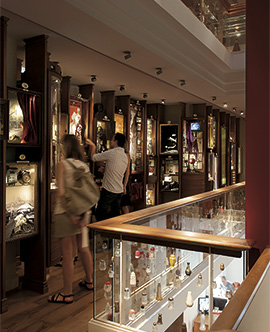Fiction and reality merge here. The house in the novel that is now a museum serves as the most important setting for an inappropriate love story in which Kemal becomes an obsessive collector of things that remind him of his true love, Füsun. This is also a story about Istanbul society back in the 1970s, torn between Western liberalism and Turkish tradition, which the museum seeks to reconcile – as a place of innocence.
Display cases for each of the 83 chapters
The narrow red house that dates back to 1897 is located on Cukurcuma Road in the south of famous Taksim Square. The story of Kemal and Füsun can be discovered here from the ground floor up to the third floor. Each of the 83 individually designed display cases shows an independent, artistically designed collage of sounds and objects that play a role in the respective chapter of the book. These can be viewed very clearly behind AMIRAN® glass from SCHOTT that features an anti-reflective coating on both sides.
”This anti-reflective glass protects the exhibits almost invisibly,” explains Matthias Anton, Sales Manager at SCHOTT. ”Thanks to its resistant high-tech coating, it allows for up to 98 percent of the light to pass through unobstructed without causing reflec-tions. This is important for display cases because there are big differences in the lighting conditions in front of and behind the glass,” he adds. SCHOTT supplied different sizes ranging from 35 x 22 cm to 289 x 121 cm for the Museum of Innocence’s customdesigned display cases.
Orhan Pamuk spent two years working on designing the exhibition with Sunder-Plassmann Architects (Kappeln, Germany), experts on museums located in old buildings. ”It is still Orhan Pamuk’s museum. We designed the display cases, lighting and exhibition sections together, but he provided all of the contents,” Brigitte Sunder-Plassmann explains. She helped to realize the author’s vision along with artists from Istanbul such as Murat Özelmaz. ”Museums are a Western invention, born out of the pride in one‘s own culture,” Pamuk told a journalist in 2008. As in the novel, in which Kemal regains his self-respect by becoming an exhibition curator rather than a fetishist, the Museum of Innocence will be presenting for the first time ever a collection of popular Turkish culture uniquely embedded in the monument of a great love story.


